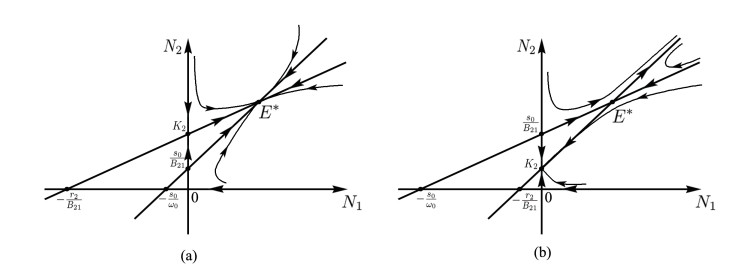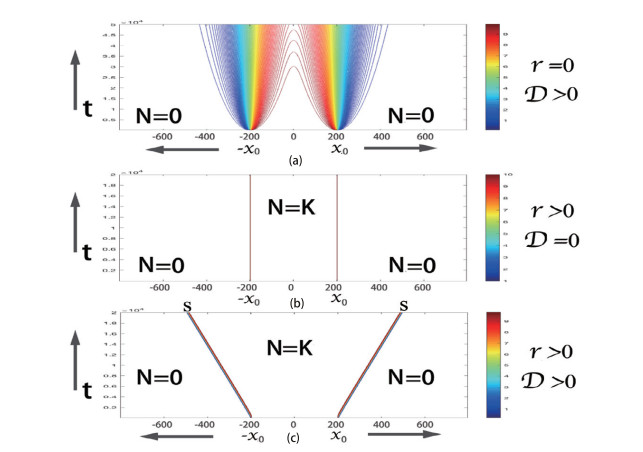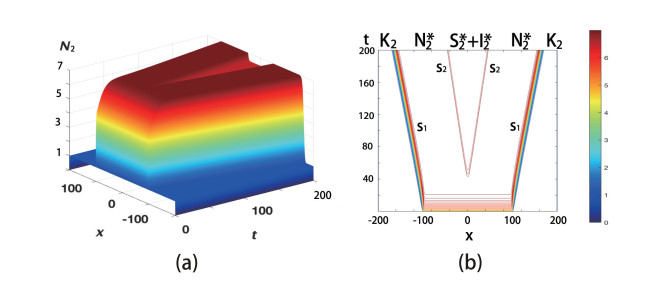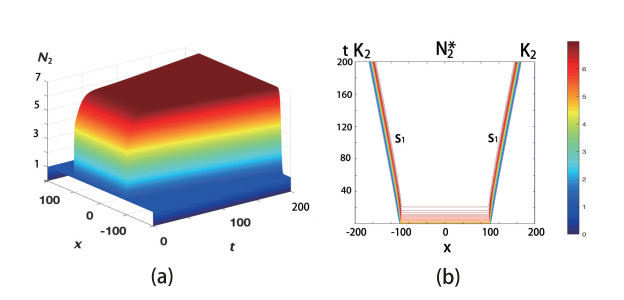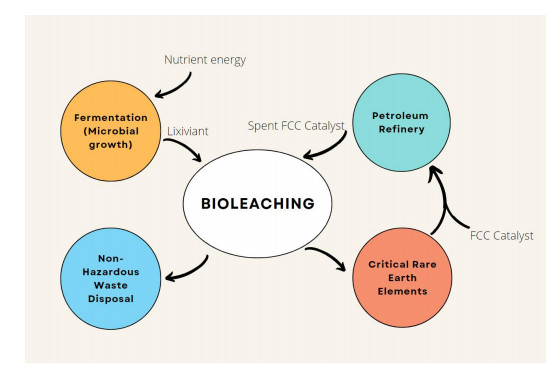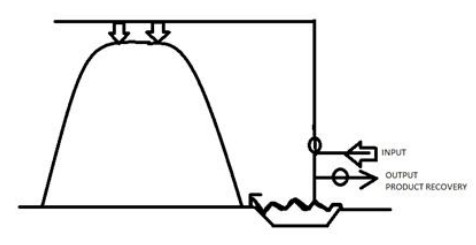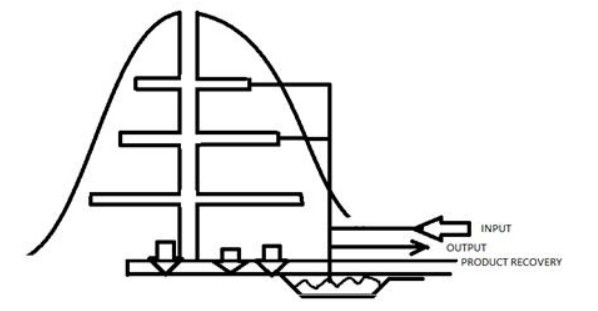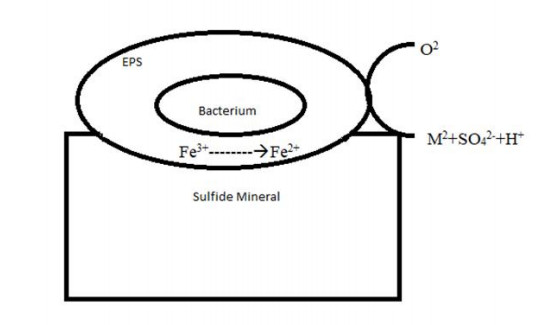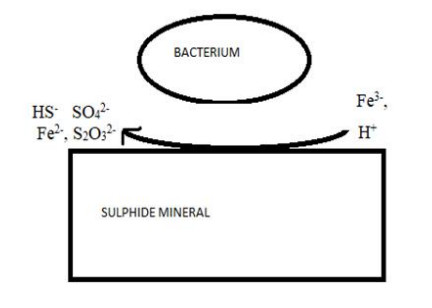1.
Introduction
Domestic pigs originated from the Eurasian wild boar (Sus scrofa), which first appeared about 9000 years ago [1]. They are essential for the transmission of swine influenza. Human beings raise domestic pigs, and then slaughter them for pork [2]. Domestic pigs grow in the food and environment provided by human beings, while human beings get the necessary nutrients by eating them. Consequently, in the breeding process, the swine flu virus is transmitted to human beings through domestic pig-human contact [2,3]. According to this process, a new breed-slaughter model with swine influenza transmission can be proposed as a model (1.1).
Domestic pig population N1(x,t) and human population N2(x,t) are assumed to be divided into 2 epidemiological compartments: susceptibles (Si(x,t)) and infectives (Ii(x,t)) at time t and location x, i=1,2. Susceptibles can become infected by means of intra-species or inter-species transmission and then recover as new susceptibles. The notation B12 represents the human breeding parameter for the population growth of domestic pigs, while B21 represents the nutrients from eating domestic pigs to increase the birth rate of human beings. The notation s0 represents the slaughter rate of domestic pigs. It's noteworthy that domestic pigs cannot survive independently without human beings, but human beings can still survive well without the supply of pork [2]. Restrictions on the development of human population mainly come from intra-species competition.
For humans, the notation r2=b2−d2 is the intrinsic growth rate of humans, where b2 and d2 represents the natural natality rate and mortality rate, respectively. K2 is the environmental carrying capacity of human population without domestic pig supply. e2 is the additional mortality rate of humans caused by swine flu. For domestic pigs, ω0 represents the intraspecific competition. During the spread of swine flu, the parameters βij represent the per capita incidence rate from species j to species i, where i,j=1,2. γi denote the recovery rate for domestic animals and humans, i=1,2. D1 and D2 are the diffusion coefficients for domestic animals and humans. It is noteworthy that all parameters mentioned above is positive.
The main purpose of this paper is to propose a new breed-slaughter model with swine influenza transmission, and study the dynamic behavior of it. And then, we focus on the invasion process of infected domestic animals into the habitat of humans. Under certain conditions as in Theorem 2, we construct a propagating terrace linking human habitat to animal-human coexistent habitat, then to swine flu natural foci, which is divided by spreading speeds. Firstly, we calculate the equilibrium points of the model without spatial heterogeneity as a model (1.2) and analyze the existence of them by the persistence theory. Secondly, we discuss their stability by the basic reproduction number. Thirdly, we use these equilibrium points to construct a propagating terrace linking them by spreading speeds.
In model (1.2), domestic pig population N1(t) and human population N2(t) are assumed to be divided into 2 epidemiological compartments: susceptibles (Si(t)) and infectives (Ii(t)) at time t, i=1,2. Other parameters are the same with model (1.1).
2.
Breed-slaughter system
At first, we focus on the breed-slaughter system without swine flu transmission and spatial heterogeneity.
If I1(0)=I2(0)=0, N1(0)>0 and N2(0)>0, model (1.2) turns to a new breed-slaughter system without swine influenza transmission as model (2.1).
Similar to the competition system in [4], breed-slaughter system also has abundant dynamic results. For the positive equilibrium point
of model (2.1), we have three cases:
(a). If B12B21<ω0r2K2 and s0<min{ω0r2B21,B12K2}, the positive equilibrium point E∗ of model (2.1) is stable (Figure 2(a)).
(b). If B12B21>ω0r2K2 and s0>max{ω0r2B21,B12K2}, the positive equilibrium point E∗ of model (2.1) is unstable (Figure 2(b)).
(c). Other than the condition as (a) or (b), the positive equilibrium point E∗ of model (2.1) does not exist.
3.
Breed-slaughter system with swine flu transmission
In order to reflect the effect of interspecific interaction on swine influenza transmission during breeding process as model (1.2), we suppose that B12B21<ω0r2K2 and s0<min{ω0r2B21,B12K2} to guarantee the existence and the stability of the boundary equilibrium point
with I1(0)=I2(0)=0 in model (1.2).
After calculation, we summarize that there are at most 6 equilibrium points in R4+ of the system (1.2): E0=(0,0,0,0), E1=(0,0,K2,0), E2=(0,0,¯S2,¯I2), E3=(N∗1,0,N∗2,0), E4=(N′1,0,S′2,I′2), E5=(S∗1,I∗1,S∗2,I∗2), where ¯S2=e2+γ2+d2β22, ¯I2=β22K2−(e2+γ2+d2)β22, N∗1=N′1=r2(s0−B12K2)B12B21K2−ω0r2, N∗2=K2(s0B21−ω0r2)B12B21K2−ω0r2, S′2=e2+γ2+d2β22, I′2=β22K2(1+s0B21−B12B21K2B12B21K2−ω0r2)−(e2+γ2+d2)β22. The exact expression of E5 is unknown. However, under certain conditions as in Theorem 2, we can obtain its existence by persistence theory [5,6,7].
If there is no domestic pigs participation, namely N1(0)=S1(0)=I1(0)=0, The persistence and the stability of boundary equilibrium E2=(0,0,¯S2,¯I2) has been proved in [8]. Similarly, we define R0=β22K1b2+e2+γ2. And then, we can get the following lemma.
Lemma 1. If N1(0)=S1(0)=I1(0)=0 and I2(0)>0, {0}×{0}×R2+ is a invariant set of system (1.2). The trivial equilibrium point E0 in model (1.2) is unstable, and we have following two cases:
(a) If R0≤1, the disease-free equilibrium point E1 of model (1.2) is stable;
(b) If R0>1, model (1.2) has a unique equilibrium point E2 in the interior of {0}×{0}×R2+, which is stable, and E1 is unstable.
Furthermore, we consider the transmission process of human influenza with domestic pigs participating, but not infected from them. Namely I1(0)=0, I2(0)>0 and Ni(0)>0, i=1,2. The persistence and the stability of boundary equilibrium E4=(N′1,0,S′2,I′2) is similar to Lemma 1. Taking E3 as the original point by coordinate translation, we can get the following lemma by the persistence theory [5,9,10], when B12B21<ω0r2K2 and s0<min{ω0r2B21,B12K2}.
According to the definition of basic reproduction number in a single population as [5,11,12], we define R1=β1N∗1s0+γ1 as the basic reproduction number of swine flu transmission in demotic pig population and R2=β22N∗2e2+γ2+d2 as the basic reproduction number of swine flu transmission in human population.
Lemma 2. If N1(0)=S1(0)>0, I1(0)=0 and I2(0)>0, R+×{0}×R2+ is a invariant set of system (1.2). The trivial equilibrium point E0 and the boundary equilibrium point E1, E2 in model (1.2) are unstable when B12B21<ω0r2K2 and s0<min{ω0r2B21,B12K2}, and we have following two cases:
(a) If R2≤1, the disease-free equilibrium point E3 of model (1.2) is stable;
(b) If R2>1, model (1.2) has a unique equilibrium point E4 in the interior of R+×{0}×R2+, which is stable, and E3 is unstable.
Next we focus on the discussion about the existence and the stability of the positive equilibrium point E5=(S∗1,I∗1,S∗2,I∗2). At first, we define Rs=max{R1,R2}. Then, we get the theorem as the following.
Theorem 1. If Ni(0)>0 and Ii(0)>0, i=1,2, R4+ is a invariant set of system (1.2). The trivial equilibrium point E0 and the boundary equilibrium point E1, E2 in model (1.2) are unstable when B12B21<ω0r2K2 and s0<min{ω0r2B21,B12K2}, and we have following three cases:
(a) If Rs≤1, the disease-free equilibrium point E3 of model (1.2) is stable;
(b) If Rs>1, R1<R2 and R1≤1, model (1.2) has a unique equilibrium point E4 except for E0, E1, E2 and E3, which is stable, and E3 is unstable;
(c) If Rs>1 and R1≥R2 (or R2>R1>1) model (1.2) has a unique equilibrium point E5 in the interior of R4+, which is stable, and E3 and E4 are unstable.
Proof. If Rs≤1, E4 and E5 do not exist. Similar to the results of Lemma 2 (a), the disease-free equilibrium point E3 of model (1.2) is stable.
Then we consider the results of system (1.2) when Rs>1 and B12B21<ω0r2K2 and s0<min{ω0r2B21,B12K2}. At first, we define
D2 and ˜D2 are forward invariant.
Let Ω∗ consists of equilibria E0, E1, E2, E3 and E4. These equilibria cannot be chained to each other in D1. By analyzing the flow in neighborhood of each equilibrium, it is easy to see that Ω∗ is isolated in D and D1 is a uniform strong repeller for ˜D2.
If x(t)=(S1(t),I1(t),S2(t),I2(t)) stays close to E2, we have two cases: if I1(0)=I2(0)=0, then I1(t)=I2(t)=0; if I1(0)>0 or I2(0)>0, then I2(t)>0. Therefore, E2 is isolated in D. Similarly, we can prove that E0, E1 and E3 are isolated in D.
For E4 and E5, we have two cases: (A). R1<R2 and R1≤1; (B). R1≥R2 or R2>R1>1.
(A). R1<R2 and R1≤1
If R1<R2 and R1≤1, E5 do not exist. Similar to the results of Lemma 2 (b), the boundary equilibrium point E4 of model (1.2) is stable.
(B). R1≥R2 or R2>R1>1
If x(t)=(S1(t),I1(t),S2(t),I2(t)) stays close to E4, we have two cases: if I1(0)=0, then I1(t)=0; if I1(0)>0, then I1(t)>0. Since (S1(t),I1(t),S2(t),I2(t)) satisfying system (1.2) has no invariant subset other than E4 in its neighborhood. E4 is isolated in D and a uniform weak repeller for ˜D2. Therefore, we can prove that E0, E1, E2, E3 and E4 are isolated in D.
Using Proposition 4.3 in [5], we can prove that D1 is a uniform weak repeller for ˜D2; and using Theorem 4.5 in [5], we can prove that D1 is a uniform strong repeller for ˜D2.
Then we get that there exists an ϵ>0 such that
with Ni(0)>0 and Ii(0)>0, i=1,2.
Therefore, if B12B21<ω0r2K2, s0<min{ω0r2B21,B12K2} and R1≥R2 (R2>R1>1), there exists at least one internal equilibrium of system (1.2) [9,10,13].
Next, we use Theorem 2 in [11] to discuss the basic reproduction number of system (1.2).
The Jacobian matrix of (I1,I2) is
Let J=F−V, F be the rate of appearance of new infections in compartment I, V be the rate of transfer of individuals out of compartment I. Then, we get
We call FV−1 be the next generation matrix for the model (1.2) and set Rs=ρ(FV−1|E3), where ρ(A) denotes the spectral radius of a matrix A.
Then we get
Finally, using Theorem 2 in [11], we can prove Theorem 1.
4.
Propagating terrace of swine flu
The basic reproduction number is an important threshold value in the research of the epidemic mathematical model, which determines the disease to break out or not. However, it is not sufficient to discuss the breed-slaughter model with interspecific interaction. The main purpose of this paper is to investigate invasion process of infected domestic animal into human habitat. And we construct a propagating terrace linking human habitat E1 to animal-human coexistent habitat E3, then to swine flu natural foci E4 (or E5), which is divided by certain spreading speeds. The propagating terrace can describe the spatio-temporal continuous change of the transmission of swine flu.
Based on the heterogeneity of the population structure and the temporal and spatial continuity of the mammal movement, the population's spatial factor is considered in the spread of swine flu. If the swine flu host populations are distributed differently in space, the diffusion term may change their local population structure, thus change the swine flu epidemic. In order to describe the population invasion process, we set the initial value is zero in the area x∈(−∞,−x0)∪(x0,∞). The area of (−x0,x0) is the original habitat of N, and N will invade to the area of x∈(−∞,−x0)∪(x0,∞) at the spreading speed s [14].
The definition of spreading speed of a single population is the positive value s satisfied with the conditions as follows,
and
in the model [4.1]
The biological description of spreading speed s has been shown in the third figure of Figure 3. The value of s approximates the inverse of the slope of the color lines. It is easy to see that the co-effect of diffusion and reproduction leads to the population territory expansion, in which the local diffusion rate D guarantees the population spatial invasion to new areas and the reproduction rate r guarantees its development on occupied areas. The spreading speed of a single population in the model [4.1] is expressed by s:=2√Dr by [14]. However, it is not enough to study the swine flu with more than one host species [15,16,17,18,19,20]. We redefine the spreading speeds at the human-animal interface, as shown below.
Due to the participation of two populations, some notations need to be redefined. The notations s and x0 are replaced by si, xi, with i=1,2, corresponding to the two swine flu host populations.
Then we construct a propagating terrace linking human habitat E1 to animal-human coexistent habitat E3, then to swine flu natural foci E4 (or E5), which is divided by certain spreading speeds. The propagating terrace can describe the spatio-temporal continuous change of the transmission of swine flu, which can be show in Theorem 2.
Theorem 2. For system (1.1), if B12B21<ω0r2K2, B21N∗1<r2 and s0<min{ω0r2B21,B12K2}, the initial conditions satisfy that 0<S1(x,0)<N∗1, x∈[−x1,x1]; S1(x,0)=0, x∈(−∞,x1)∪(x1,∞), for some x1>0; 0<I1(x,0)<N∗1, x∈[−x2,x2]; I1(x,0)=0, x∈(−∞,x2)∪(x2,∞), for some x2>0; S2(x,0)=K2, I2(x,0)=0, x∈R.
We set
Suppose that s1>s2, x1>x2, then there are three cases about the invasion process as following:
(a) Rs≤1,
The system (1.1) forms a propagating terrace, linking E1 to E3.
(b) If Rs>1, R1<R2 and R1≤1,
The system (1.1) forms a propagating terrace, linking E1 to E3, then to E4.
(c) If Rs>1 and R1≥R2 (or R2>R1>1),
The system (1.1) forms a propagating terrace, linking E1 to E3, then to E5.
Proof. The epidemic of swine flu originates in the interaction between humans and domestic animals in the breeding process, so the breaking out of swine flu would lag behind this process. Therefore, we first confirm the propagating terrace linking E1 and E3.
The breed-slaughter system without swine flu transmission can be transferred to model (4.2).
Let (N1,N2) be a solution to system (4.2) with the initial condition 0<N1(x,0)<N∗1, x∈[−x1,x1]; N1(x,0)=0, x∈(−∞,x1)∪(x1,∞), for some x1>0; N2(x,0)=K2, x∈R.
If B12B21<ω0r2K2 and s0<min{ω0r2B21,B12K2}, we claim that (N1(x,t),N2(x,t))∈Σ, ∀x∈R,t∈[0,∞), where
By the strong maximum principle, N1≥0 for t>0. Then we get
By a comparison, N2≥X, where X is the solution to
Then we get the result
Set u:=N1 and v:=N2−K2. Then ∂N2(x,t)∂t can be rewritten as
Due to u=N1∈[0,N∗1] and v=N2−K2≥0 then
By the strong maximum principle, if follows that v≤Y in R×[0,∞), where Y is the solution to
Then we have
Given ϵ>0, we choose δ>0 small enough such that 2√D1(B12K2−s0+B12δ)<s1+ϵ.
For this δ, we claim that there is τ≫1 such that Y(x,t)<δ+Mu(x,t), ∀x∈R, t≥τ, for some positive constant M. Then it follows that N1 satisfies
Therefore, according to the comparison principle and the definition of spreading speed [14,15,16,19,21], for any c∈(2√D1(B12K2−s0+B12δ),s1+ϵ), it follows that limt→+∞sup|x|>ctN1(x,t)=0, and then limt→+∞sup|x|>ctN2(x,t)=K2.
Because of the arbitrariness of ϵ, we get
Thus, if the swine flu does not break out, namely Rs≤1, for system (1.1),
Then we set U:=N∗1−N1 and V:=N∗2−N2. Similar to the proof before, we can get
If Rs≤1, for system (1.1),
Next we consider the propagating terrace linking E3 to (E4 or E5). Let (S1,I1,S2,I2) be a solution to system (1.1) with the initial condition S1(x,0)=N∗1, S2(x,0)=N∗2, I2(x,0)=0, x∈R. I1(x,0)>0, x∈[−x2,x2]; I1(x,0)=0, x∈(−∞,x2)∪(x2,∞), for some x2>0.
If B12B21<ω0r2K2 and s0<min{ω0r2B21,B12K2}, we claim that (S1(x,t)+I1(x,t),S2(x,t)+I2(x,t))∈Σ, ∀x∈R,t∈[0,∞).
For the spreading speed when Rs>1, comparison principle and strong maximum principle are no longer applicable due to the complexity of system (1.1). However, we can calculate the minimum wave speed from largest eigenvalue of its linearized system at E3 as [22] to link E3 and E4 (or E5).
For the following eigenvalue problem
where
J is the jacobian matrix,
For λ≥0, the eigenvalues of the matrix
are D1λ2+β11N∗1−(s1+γ1), D2λ2+β22N∗2−(e2+γ2+d2) and other two impossible results, which cannot define positive wave speed.
Thus, the minimum wave speed can be defined as follows, which can be divided the propagating terrace, linking E3 to E4 (or E5).
If Rs>1, there are two cases: (A). R1<R2 and R1≤1; (B). R1≥R2 or R2>R1>1.
(A). If R1<R2 and R1≤1, then E5 does not exist. s2=2√D2(β22N∗2−e2−γ2−d2), then we get
Combining the results before, linking E1 to E3, then
The system (1.1) forms a propagating terrace, linking E1 to E3, then to E4.
(B). If R1≥R2 or R2>R1>1, set s2=max{2√D1(β11N∗1−s0−γ1),2√D2(β22N∗2−e2−γ2−d2)}. then we get
The system (1.1) forms a propagating terrace, linking E1 to E3, then to E5.
5.
Simulations
If s1>s2, x1>x2 and Rs>1, R1>R2>1, then in Figure 4, the blue area represents the original habitat area of humans at the population size of E1. After domesticating pigs, the red part will be shared with the two species at E3. While after swine flu transmitting between domestic pigs and humans, the internal red part will be shared again with two populations at E5 with swine flu transmission. It is a biological description of propagating terrace of humans with swine flu transmission, which is the local spacial variation of the population.
If s1>s2,x1>x2 and Rs≤1, then in Figure 5, the blue area represents the original habitat area of humans at the population size of E1. After domesticating pigs, the red part will be shared with the two species at E3. Because Rs≤1, there is no swine flu transmission during the breed and slaughter process. Then the propagating terrace links unstable equilibrium E1 and stable equilibrium E2.
6.
Discussions
We establish a new swine flu mathematical model to reflect the dynamic process of swine flu transmission with interspecific action between domestic pigs and humans, in which the roles of different species will no longer be at the same level. Domestic pigs cannot survive independently without human beings, but human beings can still survive well without the supply of pork. By our new swine flu model, we find that the human-animal interface has promoted the cross-species transmission of swine flu and resulted in the prevalence of flu in humans. In addition, the threshold values of population development and disease transmission are also discussed in order to provide a scientific basis for future health decision makers in swine flu prevention and control. We propose the zoonotic basic reproduction number Rs, which is more applicable to the study of swine flu transmission. Then, it is analyzed that the spreading speed of different species forming propagating terraces is influenced by the intrinsic growth rate r and diffusion rate D.
In this paper, the equilibrium points of the model are calculated and we analyze the existence of the equilibrium points by the persistence theory. Then we discuss their stability by the basic reproduction number. In addition, after redefining the spreading speed, we divide the propagating terrace with two populations, which is an unprecedented task. We concern with the invasion process of infected domestic animals into the habitat of humans. Under certain conditions as in Theorem 2, we construct a propagating terrace linking human habitat to animal-human coexistent habitat, then to swine flu natural foci, which is divided by spreading speeds.
Acknowledgments
This work is supported by the National Natural Science Foundation of China, 11771044.
Conflict of interest
The authors declared that they have no conflicts of interest to this work.
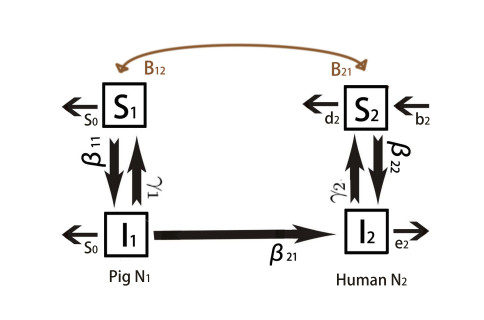









 DownLoad:
DownLoad:
